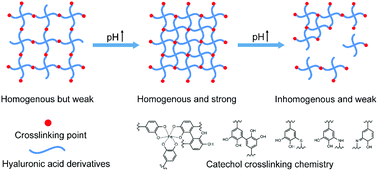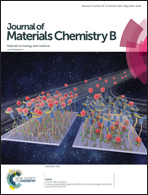The multifaceted nature of catechol chemistry: bioinspired pH-initiated hyaluronic acid hydrogels with tunable cohesive and adhesive properties†
Abstract
The field of hydrogels has rapidly expanded in recent years. A growing theme is the development of hydrogels that are bioinspired, with tailorable physicochemical properties. Marine mussels utilize their byssus to adhere themselves to rocks and thereby decrease the turbulent buffeting of the intertidal zone. An increase in pH is a noticeable phenomenon during the mussel byssus secretion and formation processes. In this study, by mimicking the acidic-to-basic pH switch that occurs during byssus formation, a series of bioinspired, pH-initiated hyaluronic acid (HA) hydrogels that possess tunable cohesive and adhesive properties were developed. Specifically, four different kinds of hyaluronic acid (HA) hydrogel crosslinking networks were fabricated by utilizing the multifaceted nature of catechol chemistry, including metal–catechol coordination, quinone–catechol dismutation, quinone–amine Michael addition and Schiff base reactions, or quinone–thiol Michael addition reactions. Our research demonstrated that pH, as one of the most important environmental variables for mussels, plays a vital role in regulating the cohesion and adhesion behaviors. And regarding the development of new materials, this biomimetic strategy also demonstrates alternative and tunable crosslinking approaches that can overcome the limitations of current HA hydrogels.



 Please wait while we load your content...
Please wait while we load your content...